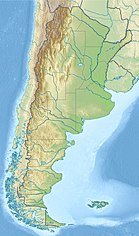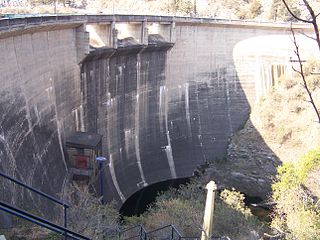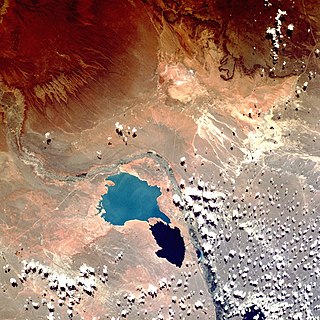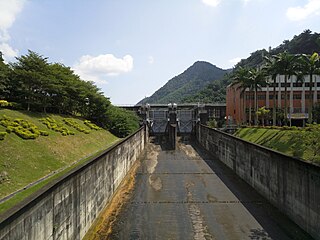| Los Reyunos Dam | |
|---|---|
 View from atop the dam | |
| Country | Argentina |
| Location | San Rafael, Mendoza Province |
| Coordinates | 34°36′8.45″S68°38′30.06″W / 34.6023472°S 68.6416833°W Coordinates: 34°36′8.45″S68°38′30.06″W / 34.6023472°S 68.6416833°W |
| Purpose | Power, water supply |
| Status | Operational |
| Opening date | 1983 |
| Owner(s) | Hirdroeléctrica Diamante (HIDISA)/Hidroeléctrica de los Nihuiles (HINISA) |
| Dam and spillways | |
| Type of dam | Embankment |
| Impounds | Diamante River |
| Height | 136 m (446 ft) |
| Length | 295 m (968 ft) |
| Reservoir | |
| Total capacity | 258,570,000 m3 (209,630 acre⋅ft) |
| Active capacity | 137,280,000 m3 (111,290 acre⋅ft) |
| Surface area | 7.34 km2 (2.83 sq mi) |
| Commission date | 1983 |
| Type | Pumped-storage |
| Turbines | 2 x 112 MW reversible Francis-type |
| Installed capacity | 224 MW |
The Los Reyunos Dam is an embankment dam on the Diamante River, in central Mendoza Province, Argentina, some twenty-two miles (thirty-five kilometers) from the city of San Rafael. The dam, built of stone and compacted clay to minimize execution and cost, is 440 feet (136 meters) high and contains a reservoir covering an area of 1,828 acres (7.34 km²). [1]
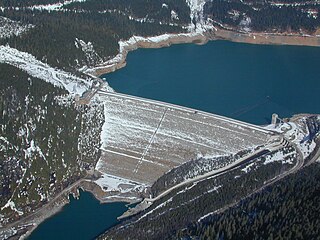
An embankment dam is a large artificial dam. It is typically created by the placement and compaction of a complex semi-plastic mound of various compositions of soil, sand, clay, or rock. It has a semi-pervious waterproof natural covering for its surface and a dense, impervious core. This makes such a dam impervious to surface or seepage erosion. Such a dam is composed of fragmented independent material particles. The friction and interaction of particles binds the particles together into a stable mass rather than by the use of a cementing substance.

The Diamante River is a river in the Argentine province of Mendoza. It is born from glaciers on the Maipo, a volcano in the Andes range in the Argentine–Chilean border, and flows east until emptying in the Desaguadero River. Its drainage basin covers an area of 2,750 square kilometres (1,060 sq mi) in the central region of Mendoza.

The Province of Mendoza is a province of Argentina, located in the western central part of the country in the Cuyo region. It borders to the north with San Juan, the south with La Pampa and Neuquén, the east with San Luis, and to the west with the republic of Chile; the international limit is marked by the Andes mountain range. Its capital city is the homonymous city of Mendoza.
The dam is used to generate hydroelectricity. This is done with a pumped-storage power station located below the level of the reservoir. About one mile (two kilometer) downstream is a smaller, compensation dam, which forms the lower reservoir, called El Tigre. During the hours of decreased power demand, water is pumped from the reservoir of El Tigre back into Los Reyunos to stabilize the water level.

Hydroelectricity is electricity produced from hydropower. In 2015, hydropower generated 16.6% of the world's total electricity and 70% of all renewable electricity, and was expected to increase about 3.1% each year for the next 25 years.

A power station, also referred to as a power plant or powerhouse and sometimes generating station or generating plant, is an industrial facility for the generation of electric power. Most power stations contain one or more generators, a rotating machine that converts mechanical power into electrical power. The relative motion between a magnetic field and a conductor creates an electrical current. The energy source harnessed to turn the generator varies widely. Most power stations in the world burn fossil fuels such as coal, oil, and natural gas to generate electricity. Others use nuclear power, but there is an increasing use of cleaner renewable sources such as solar, wind, wave and hydroelectric.
The reservoir is employed in raising Salmonidae and silverside, allowing for sport fishing. Los Reyunos Fishing and Nautical Club, along with private summer residences and a hotel, lies on the western shore of the reservoir and serves as a base for activities in the lake (such as windsurf, canoeing) and in the surrounding mountains (such as hiking).

Salmonidae is a family of ray-finned fish, the only living family currently placed in the order Salmoniformes. It includes salmon, trout, chars, freshwater whitefishes, and graylings, which collectively are known as the salmonids. The Atlantic salmon and trout of the genus Salmo give the family and order their names.

Fishing is the activity of trying to catch fish. Fish are normally caught in the wild. Techniques for catching fish include hand gathering, spearing, netting, angling and trapping. “Fishing” may include catching aquatic animals other than fish, such as molluscs, cephalopods, crustaceans, and echinoderms. The term is not normally applied to catching farmed fish, or to aquatic mammals, such as whales where the term whaling is more appropriate. In addition to being caught to be eaten, fish are caught as recreational pastimes. Fishing tournaments are held, and caught fish are sometimes kept as preserved or living trophies. When bioblitzes occur, fish are typically caught, identified, and then released.

Canoeing is an activity which involves paddling a canoe with a single-bladed paddle. Common meanings of the term are limited to when the canoeing is the central purpose of the activity. Broader meanings include when it is combined with other activities such as canoe camping, or where canoeing is merely a transportation method used to accomplish other activities. Most present-day canoeing is done as or as a part of a sport or recreational activity. In some parts of Europe canoeing refers to both canoeing and kayaking, with a canoe being called an Open canoe.
